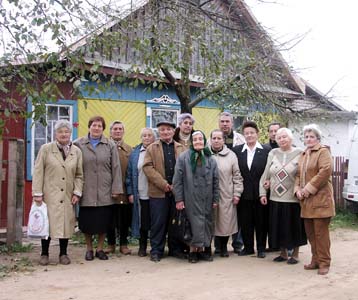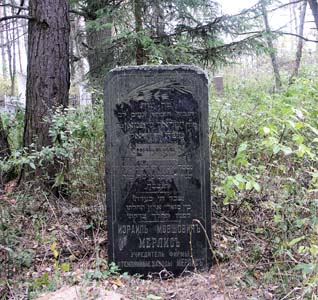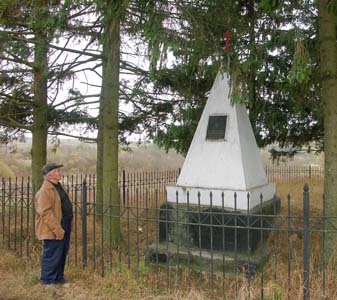

Project «Voices of Jewish settlements. Vitebsk region.»פיתוח קשרי התרבות בין העמים של ישראל ובלרוס
|
|---|
Website search |
|
MainNew publicationsContactsSite mapVitebsk regionMogilev regionMinsk regionAnatoly Shneider
|
Anatoly ShneiderTOLOCHIN JEWSThe town of Tolochin was founded in 1433 and in the third quarter of the 17th century historical documents mention new Jewish settlements Bobr, Belynichi, Gory, Glusk, Dubrovno, Krynki, Mir, Ross, Staroselie and Tolochin. From 1880 to 1905 the Jewish population of the town constituted more than 70% of the total population. Jews were traditionally involved in selling timber, cereals, vodka, fish, confectionery and small wares. Jews were also known to be excellent craftsmen: blacksmiths, potters, tailors, shoemakers, tanners, barbers and bakers. Trade, however, remained their major occupation. In 1880 Old Tolochin had 160 wooden houses, 110 of which belonged to Jewish families. New Tolochin had 93 houses, 27 of which – Jewish. There were also 4 houses made of stone – 3 in Old Tolochin and 1 in the new part. On the whole 1,119 Jews were working in Old and 253 in New Tolochin in 1880. It should be noted that from 1792 Old Tolochin was a part of the Russian Empire. New Tolochin was founded in the second quarter of the 19th century on the western bank of the Drut River and was a part of Mogilev province.  Tolochin Jews.
Tolochin Jews.
The Russian authorities put a lot of effort into the military and financial development of this region. People from other towns would come to Tolochin to buy things – there were a lot of wholesale shops, stores, kiosks and a big trade square. The shops sold everything: groceries, haberdashery, pottery, fabrics, clothes and meat. Fish was brought three times a week from places that had lakes or rivers. Right next to the trade square there was Orshanskaya (today Lenin) Street, where one big and two small synagogues were located. Men would pray on the ground floor of the big synagogue, women – on the second. The Huppah ceremonies took place in the synagogue yard. Zarechnaya (today Engels) Street was one of the longest. It started not far from the trade square, crossed the Drut River and went on westward. This is where the post office and the telegraph where located. Craftsmen also lived here: tailors, shoemakers, and blacksmiths. The street ended with a highway. Frequent fires were town’s biggest concern, since most houses were wooden. In 1897 a fire brigade was established in town. It was headed by medical assistant Yakov Shnur. Archive documents prove its workers well-trained and disciplined. Old-timers can still remember a high metal watchtower with a bell – it was located on the town square. As soon as a watchman noticed fire, he would ring the bell for the brigade to take quick action.  Tolochin. Jewish cemetery.
Tolochin. Jewish cemetery.
This watchtower is now long gone, just as the shopping street with counters made of stone. These days the place is occupied by the administrative regional council. Sofia Lvovna Rokhind, a Tolochino resident, remembers: “The fate of Yakov Shnur, an excellent doctor and fireman, was tragic. When the war broke out, he hid with his sick wife somewhere in the village. His wife died soon and the doctor was given away to Germans by “grateful” patients. He was made to walk along Tolochin streets and tortured.” Yakov Shnur, doctors Rosa and Ilya Shpitalnik were genuine intellectuals who did a lot for people. Rosa Lvovna Shpitalnik and her two children were shot by fascists. Ilya Shpitalnik helped me in June, 1941. My mother and I were walking in a small forest on the way to Tolochin and I stepped onto a sharp glass edge with a bare foot. The wound was deep and blood gushed out. Fortunately, we were picked up by a local peasant who took us to Shpitalnik’s house. The doctor said several cheering words and began working on my wound. It hurt unbearably but I did not produce a sound because I knew the doctor would compliment me. Thus, due to the accident, I became Shpitalnik’s patient at the age of 11. I am still grateful to him. The population of Tolochin constituted more than 3,700 people at the beginning of the 20th century. Before the beginning of the Great Patriotic war nearly half of the population was Jewish. They were working in crafts, trade and agriculture. Several Tolochino Jews gained world fame. In 1888 Moshe and Leya Beilin had a son who they called Israel. (In the US he was known as Irvin Berlin.) The family moved to New York in 1893. The teenager first worked in a Chinese restaurant, then became a street singer. In 1907 he published his first song. In 1911 he created his Alexander Ragtime Band. That was the beginning of the American jazz. 1918… Russia was in the flames of the Civil war. Its echo reached America and the 30-year-old composer was recruited to the Army. There he made drafts of his song “God bless America”. In 1938 the whole world was expecting the war. On November 10th and 11th, fascists organized pogroms all over the country. Berlin came back to the forgotten idea. And on November 11th Kate Smith sang the hymn “God bless America” on the radio. The hymn was written by Izia Beilin, a man from Tolochino. The song gained enormous popularity in America and Irvin became a national hero. He lived to the age of 101 and wrote more than 1,000 songs. A postal stamp was printed in the US in 2002 in his honor. America has not forgotten the maestro. We hope that Irvin Berlin’s songs will one day be played in Tolochin. Sofia (Sprintz) Lvovna Rokhind was born in a Jewish family in Tolochin in 1903. Her father was a skilled watch repairer and worked with jewelry. Apart from Yiddish, he could speak Russian, German and Hebrew. He read a lot and subscribed to Jewish newspapers in Yiddish and Hebrew. Sofia read Tanach with her father and grandfather and loved Yiddish. Sofia’s mother was from a place called Obolets and was also rather well educated. The girl lost her parents very early and was brought in her grandfather’s house. After graduating from university in 1928, she worked as a teacher in the Jewish sector of the Belorussian Science Academy, which did research in Jewish history, literature, folklore and linguistics. As a result of Stalin’s campaign the department was eventually closed and Sofia Rokhind, together with G. Shklar, was transferred to the institute of Belarusian language and literature. In 1950 Sofia was removed from her position and was told that the institute was interested in workers of “native origin”. When she said that she originated from Belarus and all of her roots were Belarusian, she was told cynically: “You have the wrong roots.” In 1939 Sofia Lvovna, together with G. Shklar, finished working on the Yiddish-Russian dictionary, which, due to ideological obstacles, was only published in 1941, even though the dictionary cover says 1940… On June 2nd, 1941 Minsk was on fire after heavy bombing. S. Rokhind and G. Shklar, who were at that time in their office, decided: if Germans broke into the building, they would jump out of the window. Sofia managed to walk out of Minsk unharmed. She lived in evacuation in the Urals and in Kazakhstan. After Minsk was liberated in 1944, she came back and worked at Minsk Pedagogy institute.  Memorial on the execution site of Tolochin Jews.
Memorial on the execution site of Tolochin Jews.
In 1996-1998, when she was almost blind, Sofia wrote memoirs about the town of her childhood. “I remember our pre-revolutionary Tolochin to the slightest detail; I remember many people that I saw in shops, workshops and in the streets. It seems to me they were good honest people. I do not remember that someone was discussed as a thief or a swindler.” Sofia Rokhind was a kind-hearted woman and helped people as much as she could. She had a lot of students and left only positive memories about herself. She died at 97. Holocaust in TolochinJust as other places in Belarus, Tolochin had a ghetto from the first days of the German occupation. From June to October, 1941, special settlements were established in villages Slavnoye, Oboltsy, Tolochin and Kohanovo. At the beginning of the war a German officer lived in Zoya Maksimovna Kipriyanets’ apartment. Once, while cleaning his room, she noticed a printed paper on the table. It was Hitler’s appeal to the German army stating that the more Jews and Russians were killed, the better future was awaiting the Germans. Apparently, the officer was sure that “the Russian pigs” would not know German and was so careless. In Spetember, 1941, a ghetto was established in Tolochin in Nikolskaya (now Pushkin) Street. All the people living in this street were moved out and Jewish families from Tolochin and neighboring settlements were brought here. All the valuables were taken; every house had five-six families. People were not allowed to leave and were forced to work. On a March day, 1942, several Jews were pushed with guns to Tolochin suburb and forced to dig a big ditch. And the following morning Tolochin residents shuddered at the sight of half-dressed ghetto dwellers pushed out of their houses, including children and old people.  Memorial on the execution site of Tolochin Jews.
Memorial on the execution site of Tolochin Jews.
Soon the column of prisoners started moving towards the ditch. Several people tried to escape and were shot. That day fascists executed the innocent people. They were accused of being Jews. During the execution a Nazi tore a Jewish baby in two and threw it into the grave… The ground was moving for a long time after the execution and was red from human blood. One could hear muffled groaning of those who had fallen into the grave alive. After the war the victims’ relatives erected a burial mound on the site. There is an unpretentious obelisk with a tab: “Here lie victims of fascist terror – more than 2,000 Jews from Tolochin and its suburbs, executed on March 13th, 1942.” Very few people were saved. Among them there was a Jewish boy Honia, aged 10 or 11. On a frosty day my father went to the barn to get some straw and suddenly noticed the straw stack was moving. - Who is here? – he called. Then he saw the scared exhausted boy. He said he had escaped Germans in Porechie and came here because his grandfather Shmuila used to work here before the war. I still remember the old man really well - he was an excellent craftsman, made horseshoes, knives, axes and many other things. He was also shot by Germans. Father took Honia to our house. The boy was washed, fed, given new clothes and hidden from Germans. Later he was hidden by a woman from our village. After the war Honia often visited her, brought presents and helped her with money. When she died, he buried her and put a tombstone on her grave. I do not know about his life afterwards. At that difficult time there still were kind-hearted people who chose to put their lives at stake and saved Jews. They did it because their hearts told them so. Unfortunately we do not know all their names today. One of them was Olga Ustinovna Pleskach, from Lazy, Tolochin region She was saving Jews during the war. Yad Vashem instated her later as the Righteous among the Nations. Almost all the Jews in Tolochin were executed. Only those who had left town in advance got lucky. Israel Abramovich Krivosheyev from Tolochin left the town with his wife Basia Adolfovna and children Adolf, Semen, Miron and Ilya. Eventually they reached Central Asia. The father died there in 1942 from hard work and heat, mother - in 1943. In September, 1943, Ilya Israelevich was recruited to the army and later sent to the battlefront to Belarus. His brothers Miron, Adolf and Alexander also fought in the war. |
|||
|
|
Jewish settlements in Vitebsk regionVitebsk • Albrehtovo • Babinovichi • Baran • Bayevo • Begoml • Beshenkovichi • Bocheikovo • Bogushevsk • Borkovichi • Braslav • Bychiha • Chashniki • Disna • Dobromysli • Dokshitsy • Druya • Dubrovno • Glubokoye • Gorodok • Kamen • Kohanovo • Kolyshki • Kopys • Krasnopolie • Kublichi • Lepel • Liady • Liozno • Lukoml • Luzhki • Lyntupy • Miory • Obol • Oboltsy • Orsha • Osintorf • Ostrovno • Parafianovo • Plissa • Polotsk • Prozorki • Senno • Sharkovshina • Shumilino • Sirotino • Slaveni• Smolyany • Surazh • Tolochin • Ulla • Verhnedvinsk • Vidzy • Volyntsy • Yanovichi • Yezerishe • Zhary • Ziabki • |
Main |
New publications |
Contacts |
Site map |
Vitebsk region |
Mogilev region |
Minsk region |